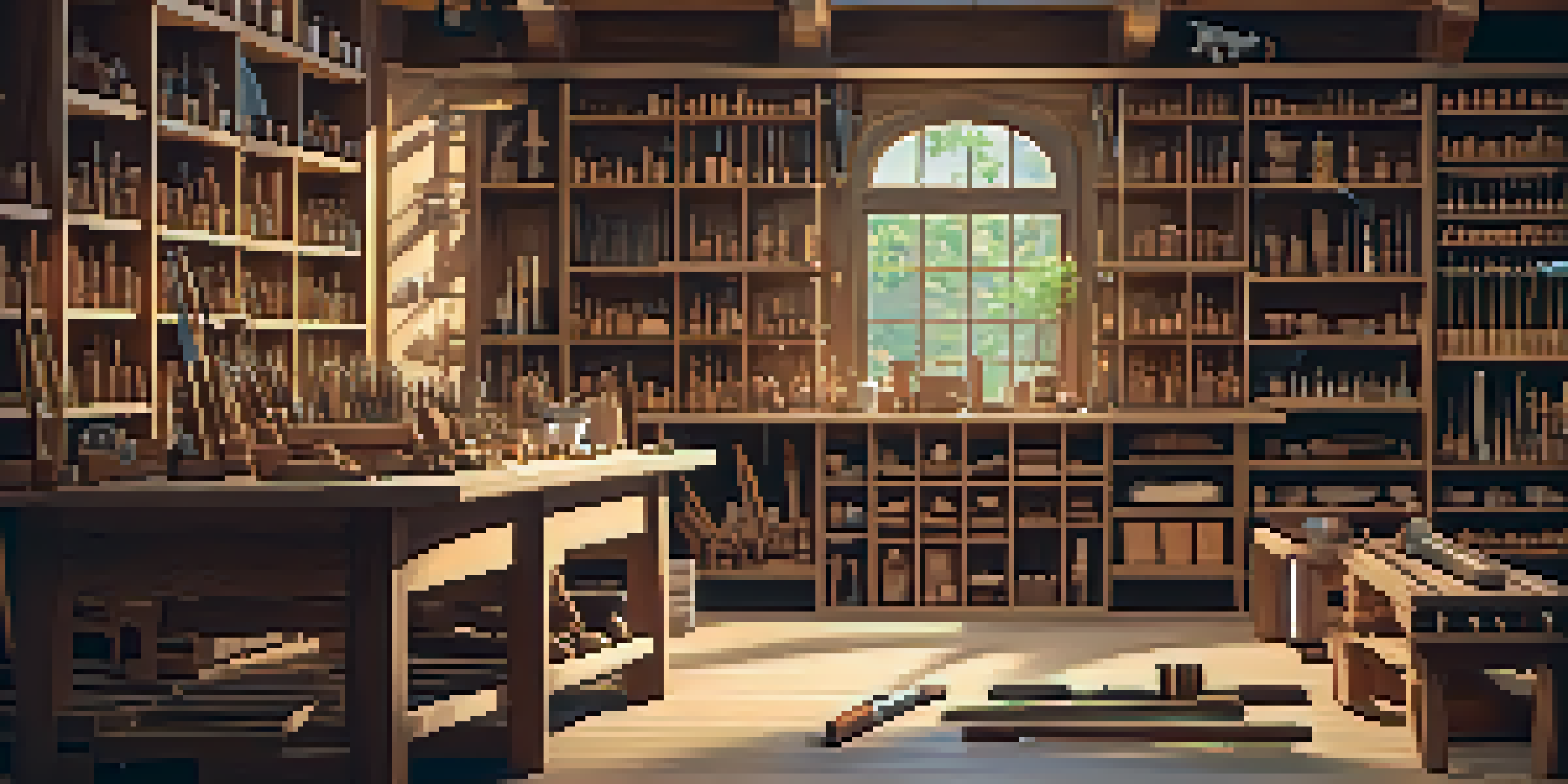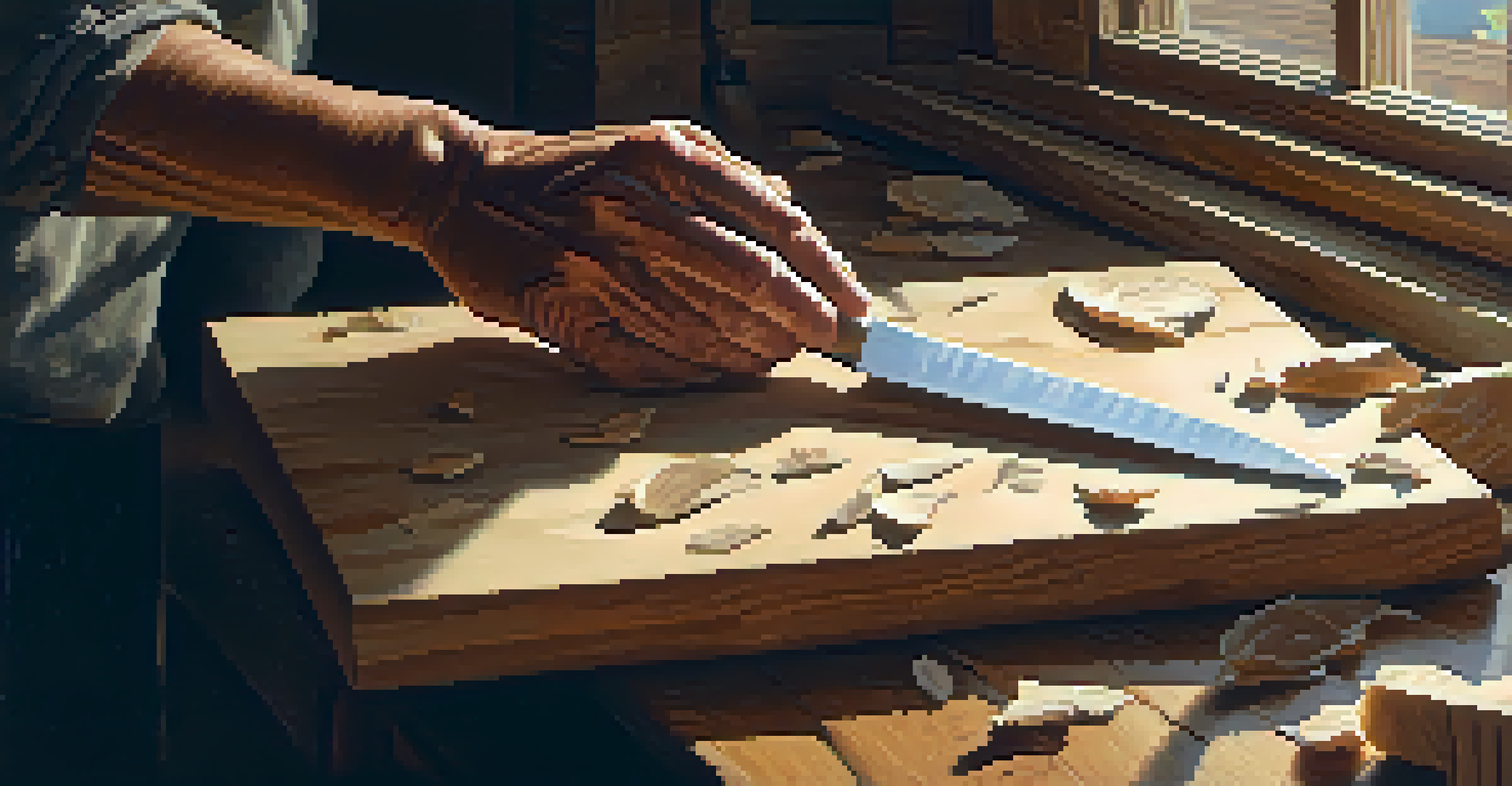Essential Tools for Wood Carving: A Comprehensive Guide

Understanding the Basics of Wood Carving Tools
Before diving into the specifics, it's important to understand what wood carving entails. At its core, wood carving is the art of shaping wood into decorative or functional pieces using various tools. The right tools can make a significant difference in the quality and ease of your work.
The best carpenter is the one who has a good toolbox.
Different types of wood carving require different tools. For instance, relief carving may call for specific gouges, while whittling might only require a sharp knife. Knowing the basics helps you choose the right tools for your projects.
Ultimately, investing time in learning about your tools can enhance your skills and enjoyment of wood carving. Just like a painter needs quality brushes, a woodworker thrives with the right instruments in hand.
Essential Knives for Wood Carving Projects
A good carving knife is one of the most fundamental tools in wood carving. These knives come in various shapes and sizes, each designed for different types of cuts. A general-purpose carving knife, for example, is perfect for creating detailed shapes and contours.

When selecting a carving knife, look for one with a comfortable handle and a sharp, durable blade. The right knife will not only improve your efficiency but also make your carving experience more enjoyable. Remember, a dull knife can lead to frustration and accidents.
Choosing the Right Carving Tools
Selecting the appropriate knives, chisels, and gouges is essential for achieving quality results in wood carving.
As you gain experience, you might want to experiment with specialty knives, such as detail knives or hook knives. Each offers unique capabilities that can expand your creative possibilities in wood carving.
Discovering the World of Chisels and Gouges
Chisels and gouges are essential tools for more intricate wood carving tasks. Gouges, with their curved blades, help create soft lines and rounded shapes, while chisels are perfect for precise cuts. Together, they allow for a wide range of artistic expression.
A woodcarver is not just a craftsman; they are a sculptor, a visionary who sees the potential within the wood.
When choosing chisels and gouges, consider the width and curvature of the blades. A variety of sizes will enable you to tackle different projects with ease. For beginners, a basic set that includes a few sizes can be a great starting point.
As you become more comfortable with these tools, you'll find that they open up new avenues for creativity. The right gouge or chisel can transform a simple block of wood into a stunning work of art.
The Importance of a Quality Wood Carving Mallet
A mallet is often an overlooked but essential tool in wood carving. It serves as a striking instrument to help drive chisels and gouges into the wood, making it crucial for effective carving. A well-balanced mallet can enhance your control and precision.
When selecting a mallet, consider the material, weight, and size that best fits your comfort and carving style. Many carvers prefer wooden mallets for their balance and feel, while others might choose rubber for a softer impact.
Maintaining Tools for Longevity
Regular maintenance and proper storage of your wood carving tools can significantly extend their lifespan and performance.
Using a mallet correctly can reduce hand fatigue and increase efficiency, allowing you to focus on your creativity rather than struggling with your tools.
Exploring Specialty Tools for Advanced Carving
As you advance in your wood carving journey, you may want to explore specialty tools that can elevate your work. Tools like V-tools are perfect for creating fine lines and details, while curved chisels can help carve intricate shapes.
Specialty tools can add a new dimension to your projects, allowing for more creativity and detail. While they may not be necessary for every carver, they can be invaluable for specific techniques or styles.
Investing in a few specialty tools can significantly enhance your skillset. Just remember, the more you practice, the more adept you'll become at using these advanced tools.
Maintaining Your Wood Carving Tools for Longevity
Proper maintenance of your wood carving tools is crucial for ensuring their longevity and performance. Regularly sharpening your blades and keeping them clean can make a world of difference. A sharp tool is not only safer but also more efficient.
Make it a habit to inspect your tools after each use. Look for any damage, rust, or dullness, and address these issues promptly. Investing time in maintenance can save you money in the long run by prolonging the life of your tools.
Creating an Inspiring Workspace
A well-organized and personalized carving workspace can enhance your productivity and creativity during projects.
Additionally, storing your tools properly can help prevent wear and tear. Consider using a designated tool box or pouch to keep them organized and protected between carving sessions.
Finding the Right Wood for Your Carving Projects
Choosing the right type of wood is just as important as having the right tools. Different woods have varying densities, grain patterns, and textures, which can significantly impact your carving experience. Softer woods like basswood are ideal for beginners due to their ease of carving.
As you gain experience, you might want to experiment with harder woods such as oak or cherry. These woods can provide beautiful finishes and intricate details but may require more skill and effort to carve.

Ultimately, the type of wood you choose can influence the final outcome of your project. Take the time to explore various woods and find what works best for your style and skill level.
Building a Wood Carving Workspace for Success
Creating a dedicated workspace for wood carving can greatly enhance your productivity and focus. A well-organized area with proper lighting, tools, and materials can make your carving sessions more enjoyable and efficient. Consider a sturdy workbench and comfortable seating to support your craft.
Additionally, ensuring your workspace is free from clutter can help you stay focused on your projects. Having all your tools within reach will minimize distractions and keep your creative flow going.
Finally, don't forget to personalize your space! Adding elements that inspire you can make your workspace not just functional but also a reflection of your artistic journey.